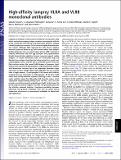High-affinity lamprey VLRA and VLRB monoclonal antibodies
Author(s)
Wittrup, Karl Dane; Pancer, Zeev; Mariuzza, Roy A.; Flajnik, Martin F.; Xu, Gang; Velikovsky, C. Alejandro; Tasumi, Satoshi; Gai, S. Annie; ... Show more Show less
DownloadTasumi-2009-High-affinity lampre.pdf (501.0Kb)
PUBLISHER_POLICY
Publisher Policy
Article is made available in accordance with the publisher's policy and may be subject to US copyright law. Please refer to the publisher's site for terms of use.
Terms of use
Metadata
Show full item recordAbstract
Lamprey are members of the ancestral vertebrate taxon (jawless fish), which evolved rearranging antigen receptors convergently with the jawed vertebrates. But instead of Ig superfamily domains, lamprey variable lymphocyte receptors (VLRs) consist of highly diverse leucine-rich repeats. Although VLRs represent the only known adaptive immune system not based on Ig, little is known about their antigen-binding properties. Here we report robust plasma VLRB responses of lamprey immunized with hen egg lysozyme and β-galactosidase (β-gal), demonstrating adaptive immune responses against soluble antigens. To isolate monoclonal VLRs, we constructed large VLR libraries from antigen-stimulated and naïve animals in a novel yeast surface-display vector, with the VLR C-terminally fused to the yeast Flo1p surface anchor. We cloned VLRB binders of lysozyme, β-gal, cholera toxin subunit B, R-phycoerythrin, and B-trisaccharide antigen, with dissociation constants up to the single-digit picomolar range, equivalent to those of high-affinity IgG antibodies. We also isolated from a single lamprey 13 anti-lysozyme VLRA clones with affinities ranging from low nanomolar to mid-picomolar. All of these VLRA clones were closely related in sequence, differing at only 15 variable codon positions along the 244-residue VLR diversity region, which augmented antigen-binding affinity up to 100-fold. Thus, VLRs can provide a protective humoral antipathogen shield. Furthermore, the broad range of nominal antigens that VLRs can specifically bind, and the affinities achieved, indicate a functional parallelism between LRR-based and Ig-based antibodies. VLRs may be useful natural single-chain alternatives to conventional antibodies for biotechnology applications.
Date issued
2009-06Department
Massachusetts Institute of Technology. Department of Biological Engineering; Massachusetts Institute of Technology. Department of Chemical Engineering; Koch Institute for Integrative Cancer Research at MITJournal
Proceedings of the National Academy of Sciences of the United States of America
Publisher
United States National Academy of Sciences
Citation
Tasumi, Satoshi et al. “High-affinity lamprey VLRA and VLRB monoclonal antibodies.” Proceedings of the National Academy of Sciences 106.31 (2009): 12891-12896. © 2009 National Academy of Sciences
Version: Final published version
ISSN
1091-6490
0027-8424